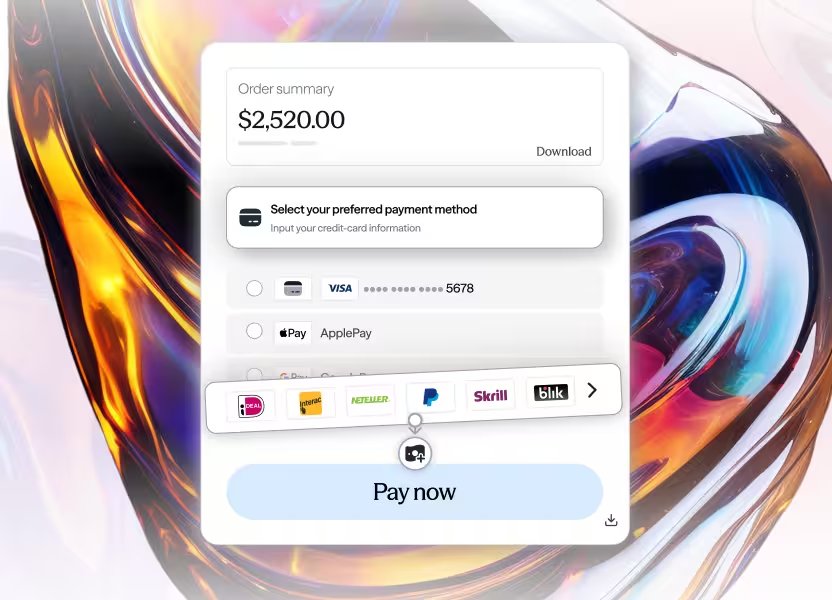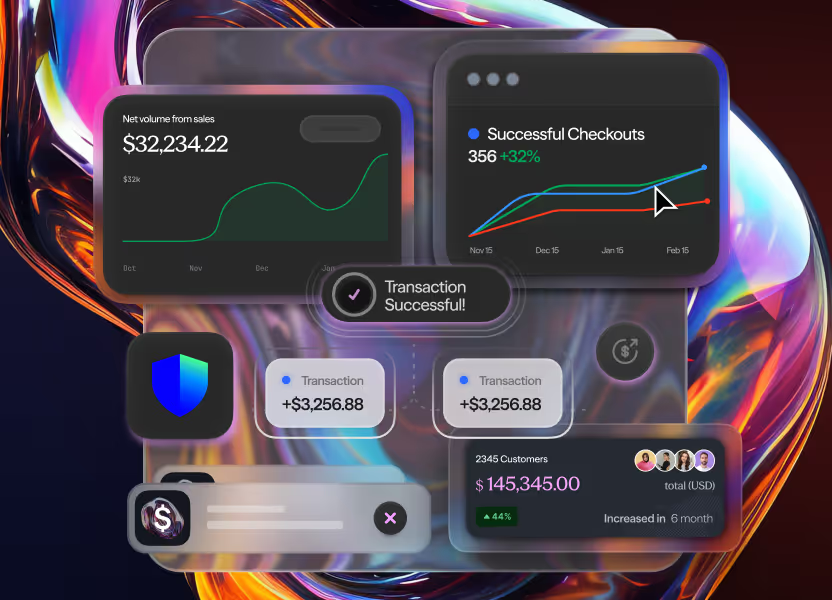Going Global with Alternative Payment Methods (APMs): A Strategic Guide for Merchants
Alternative Payment Methods (APMs) help merchants expand globally and boost conversions.
.avif)
Alternative Payment Methods (APMs) are reshaping payments, moving beyond the traditional dominance of credit and debit cards. For merchants looking to expand internationally, understanding and adopting APMs is no longer a luxury but a necessity for business growth. This in-depth guide will explore what APMs are, why they are crucial for a global strategy and how to successfully integrate them to expand to new markets and boost your revenue.
What are Alternative Payment Methods?
An Alternative Payment Method (APM) is any payment method other than a major credit card scheme like Visa or Mastercard. APMs are a diverse category, encompassing everything from digital wallets and real-time bank transfers to local card schemes and "Buy Now, Pay Later" (BNPL) options. They reflect the unique and often deeply rooted payment habits of consumers in different regions around the world.
Examples of APMs include:
- Digital Wallets: These platforms store a user's payment information and allow for quick, seamless transactions online and in-app. Think of global players like Apple Pay and Google Pay, or regional giants like Alipay and WeChat Pay in Asia.
- Real-Time Bank Transfers: These payments move funds directly from a customer's bank account to the merchant's, often bypassing card networks entirely. This category includes popular solutions like Open Banking in Europe and PIX in Brazil.
- Local Payment Methods: Many countries have their own preferred domestic payment systems. Examples include Blik in Poland and PayID in Australia.
- Buy Now, Pay Later (BNPL): Services like Klarna and Afterpay allow customers to pay for their purchases in interest-free instalments.
- Cryptocurrency: Digital currencies like Bitcoin and Ethereum are emerging as a decentralised payment option for tech-savvy consumers.
Why APMs are Essential for Global Merchants
You might have a brilliant product, but if your checkout doesn't speak the local language of payments, your customers will simply walk away. Adopting a robust APM strategy directly addresses this and delivers concrete benefits for your business:
1. Boosts Conversion and Reduces Cart Abandonment
Let’s say a customer from Germany is ready to buy your product. They get to your checkout and only see a credit card option. They would prefer to use SOFORT, a familiar bank transfer method they trust. If that option isn't there, there's a high chance they will abandon their cart.
2. Opens Doors to Underserved Markets
In many parts of the world, credit card penetration is low but mobile phone usage is sky-high. This creates a huge opportunity. By offering APMs like mobile wallets and real-time bank transfers, you can tap into massive, previously unreachable markets with large "unbanked" or "underbanked" populations.
3. Builds Trust and Local Credibility
When you expand into a new country, you are not just selling a product. You are building a relationship. Showing that you understand and respect local payment habits instantly builds credibility and makes you look like a trusted local partner rather than a foreign brand.
4. Improves Security and Reduces Costs
Many APMs offer enhanced security features that are often superior to traditional card payments, using biometric authentication and tokenisation to protect customer data. Plus, many come with lower transaction fees, which can lead to significant savings as your transaction volume grows.
Key Pain Points Solved by APMs
Merchants often face a number of challenges when trying to go global and APMs provide direct solutions.
- Low Approval Rates: In many regions, credit card declines are common due to fraud concerns or issuer limitations. Routing transactions through local APMs are often a trusted part of the domestic financial infrastructure and merchants can achieve significantly higher approval rates.
- Complex Integrations: Trying to integrate with dozens of different regional payment providers is a technical nightmare. A payment orchestration platform like finera. provides a single integration to a vast global network of acquirers and APMs, simplifying a complex process and allowing you to rapidly enter new markets without extensive in-house development.
- Limited Global Reach: A card-only payment stack severely limits your ability to scale internationally. Embracing APMs allows you to reach a wider, more diverse audience and expand into markets that are traditionally difficult to penetrate with standard payment methods.
Going Live: A Strategic Approach to APMs
Successfully integrating APMs requires more than just adding a few logos to your checkout page. It's about a strategic, data-driven approach.
- Understand Your Target Markets: Research the preferred payment methods in the countries you want to expand into. For example, in Poland, Blik is a must-have, while in Brazil, PIX dominates. Don't assume that what works in one region will work everywhere.
- Partner with a Payment Orchestration Platform: This is the most efficient way to manage a diverse payment stack. A payment orchestration platform acts as a central hub, connecting you to multiple gateways, acquirers and APMs through one unified API. This technology also enables smart routing, which intelligently directs transactions to the best-performing provider for each specific payment, further optimising approval rates and reducing friction.
- Prioritise Integration: Focus on the APMs that align with your highest-value target markets. For instance, if you're an iGaming merchant expanding into the CIS region, solutions like Humo and Uzcard are crucial.
- Optimise the Checkout Experience: Ensure your checkout page is localised and user-friendly. Clearly display the logos of the APMs you support, and make the process as simple and fast as possible. Real-time analytics can help you track performance and make data-driven decisions to continuously improve your payment strategy.
Data-Driven Insights into Global Payments
The global e-commerce payment landscape is undergoing a significant transformation, with a decisive shift towards Alternative Payment Methods. According to the Global Payments Report 2025, digital wallets are projected to dominate, growing from 53% of transaction volume in 2024 to an impressive 65% by 2030. This surge highlights their convenience and widespread adoption, particularly in mobile-first economies.
Conversely, the market share of traditional credit and debit cards is expected to decline, with credit cards dropping from 20% to 13% and debit/prepaid cards falling from 12% to 7% in the same period. Account-to-account (A2A) payments are also on the rise, forecast to increase from 7% to 9%, underscoring the growing preference for direct bank transfers. Even "Buy Now, Pay Later" (BNPL) services, while maintaining a stable 5% share, continue to be a significant player, offering flexible payment options that appeal to modern consumers. This data unequivocally reinforces the critical need for merchants to embrace a diverse payment strategy, moving beyond card-centric approaches to capture the vast and evolving global market.
.avif)
How to Successfully Integrate APMs: A Step-by-Step Guide
Successfully integrating APMs requires a strategic approach. It's not about adding every single option; it's about adding the right ones.
1. Know Your Markets
Start with research. Understand which payment methods are most popular in the countries you’re targeting. For a merchant expanding into the iGaming sector in the CIS region, solutions like Humo and Uzcard are crucial. For a business in Europe, Open Banking is a must-have. Localisation is key.
2. Don’t Get Started Alone
The most efficient and scalable way to manage a diverse payment stack is with a payment orchestration platform. This single platform acts as a central hub, connecting you to multiple gateways, acquirers and APMs through one unified API. This technology also allows for smart routing, which intelligently directs each transaction to the best-performing provider, optimising approval rates and ensuring a seamless experience.
3. Optimise the Checkout
Ensure your checkout is localised, fast and easy to use. Clearly display the logos of the APMs you support and make the process as simple as possible. Your goal is to give the customer exactly what they want, right when they need it. Use real-time analytics to track which payment methods are performing best and continuously refine your strategy.
Power Your Global Growth with finera’s APMs Expertise
finera. is more than just a payment provider. We are a technology partner built to help you conquer new markets. Our payment orchestration platform gives you a single, powerful integration to a vast global network of Alternative Payment Methods, covering regions such as Europe, LATAM, APAC and CIS.
We also support core services like card processing and crypto payments, all under one roof. Our multi-rail approach, powered by a sophisticated smart routing engine, ensures superior payment performance, higher approval rates, and a truly global reach for your business.
Ready to stop leaving money on the table? Your customers are waiting to pay you in a way that feels familiar and secure.
Get started with our team today.
This article on payment methods is for informational and educational purposes only.
- Not Professional Advice: The content provided does not constitute financial, legal, tax, or professional advice. Always consult with a qualified professional before making financial decisions.
- No Liability: The authors, contributors, and the publisher assume no liability for any loss, damage, or consequence whatsoever, whether direct or indirect, resulting from your reliance on or use of the information contained herein.
- Third-Party Risk: The discussion of specific payment services, platforms, or institutions is for illustration only. We do not endorse or guarantee the performance, security, or policies of any third-party service mentioned. Use all third-party services at your own risk.
- No Warranty: We make no warranty regarding the accuracy, completeness, or suitability of the information, which may become outdated over time.
Frequently Asked Questions

Still Have Questions?
Let’s Find the Right Solution for You
Stay Connected with Us!
Follow us on social media to stay up to date with the latest news, updates, and exclusive insights!




.avif)




